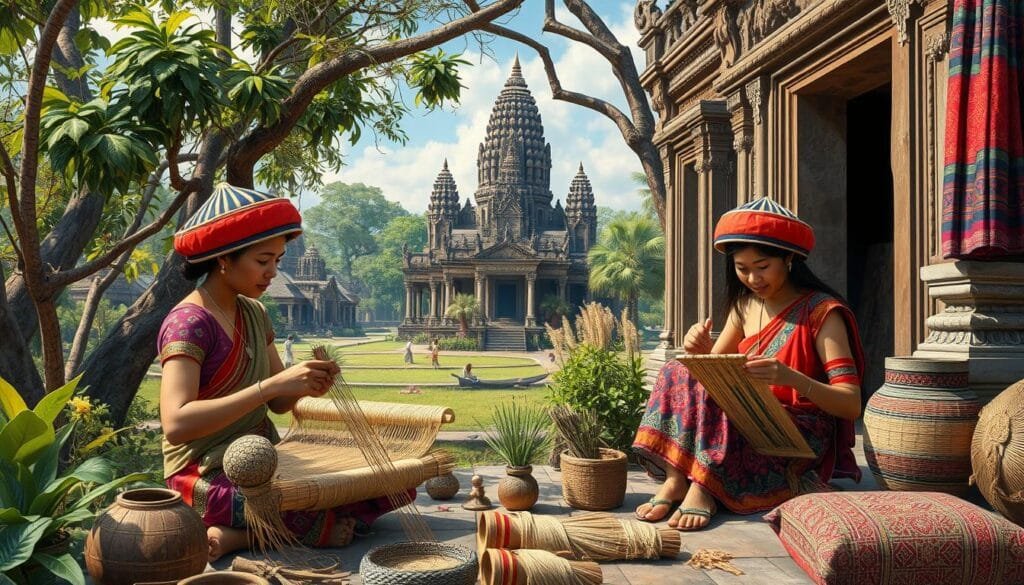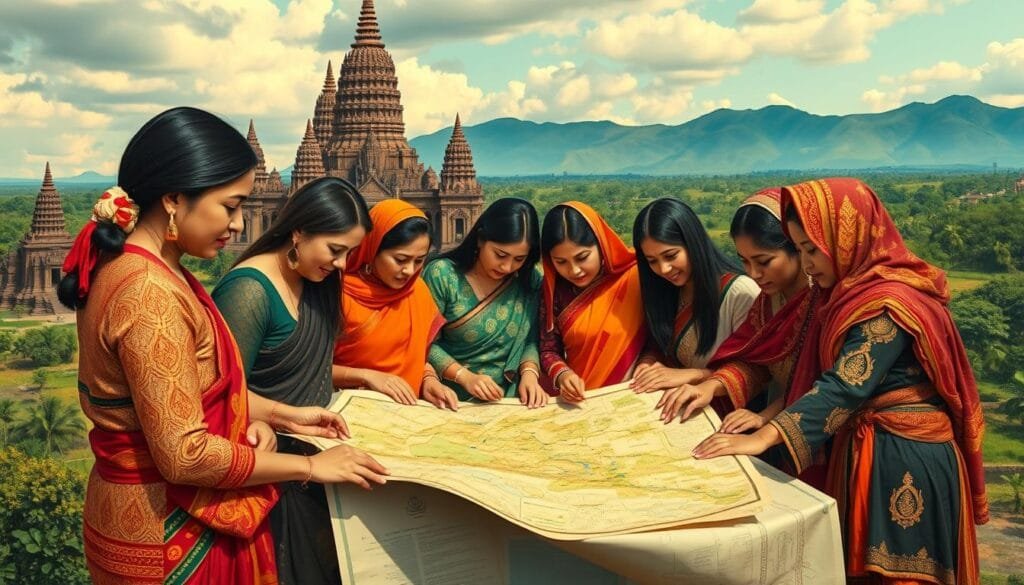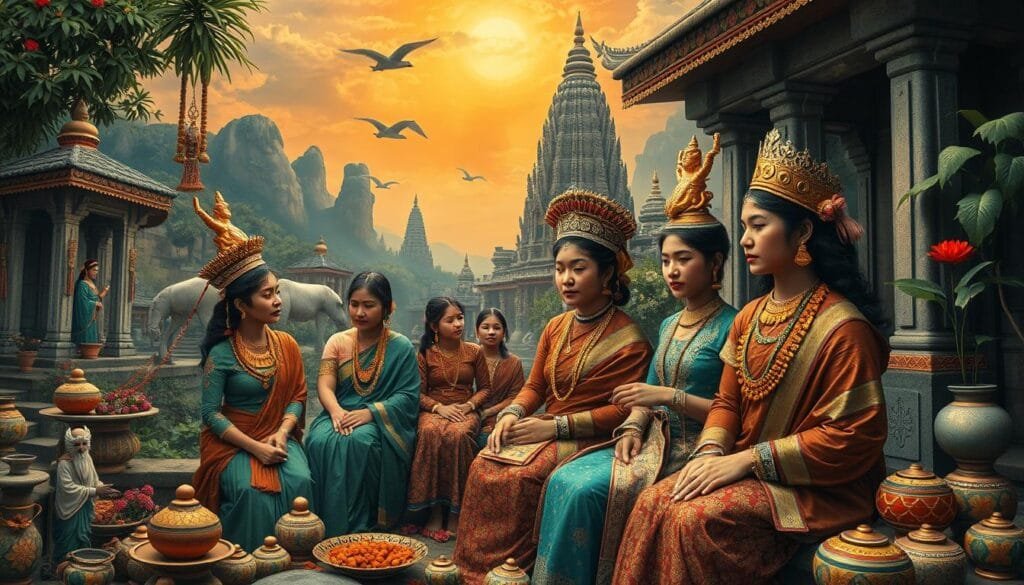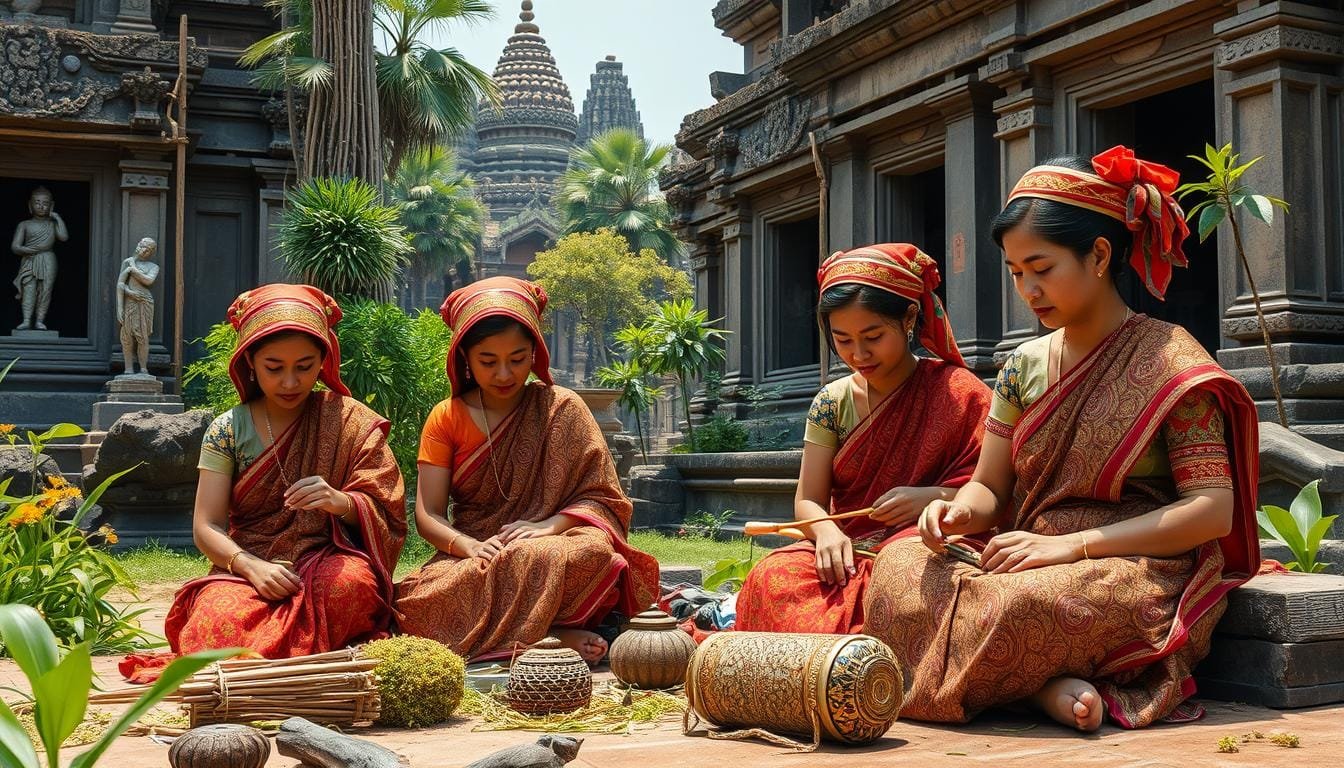Can we fully grasp Angkor Wat’s grandeur without recognizing women’s deep cultural influence then? Women in the Angkor era were key in art, religion, and society. They left a lasting effect seen in history and temple art, yet often ignored today.
In post-conflict societies like Cambodia, women make up over half the population. Their historical input is vast. During Angkor’s peak, women weren’t just home-bound. They engaged in religious, political, and cultural fields, marking a noteworthy legacy.
This article shines a light on women’s various roles in Angkor’s society. Their empowerment in history and culture is our focus. We’ll look into Apsaras at Angkor Wat, the meaning behind temple art, and Kent Davis’s research.
Key Takeaways
- Angkor era women had a deep and complex cultural impact, seen in temple art and religious acts.
- Apsaras and devatas provide insights into historical roles of women.
- Kent Davis’s studies offer fresh views on women’s status in Angkor society.
- Apart from royalty, women had a big role in governance and societal structures.
- Acknowledging their efforts is crucial for a full understanding of Angkor civilization.
The prominence of Apsaras in Angkor Wat
Apsaras, or celestial nymphs, are central to Cambodian culture, especially in Angkor Wat. Their art in the temple, symbolism, and Kent Davis’s research highlight their deep significance.
Representation in Temple Art
Apsaras grace Angkor Wat’s bas-reliefs in elegant poses. These poses mirror the traditional Apsara dance from the 9th to 15th centuries. Their roles in ceremonies and festivities are told through this temple art.
Symbolic Significance
Apsaras are more than just beautiful figures in art. They embody Cambodian cultural identity. Their dance, captured in stone and murals, plays a key part in state and religious events. It shows their importance in Khmer culture.
| Aspect | Details |
|---|---|
| Historical Period | 9th to 15th centuries |
| Training Duration | Up to 15 years |
| Number of Hand and Finger Gestures | 1,500 |
| Current Performers | 300 |
| Annual Visitors to Angkor Wat | Over 2.5 million in 2022 |
| UNESCO Recognition Year | 2003 |
Kent Davis’s Research Findings
Kent Davis uncovered fascinating details about Apsaras. His work shows Apsara dancers start training young, sometimes before 10 years old. The training could stretch for 15 years. Over 3,000 dancers lived during King Jayavarman VII’s time. Davis’s findings emphasize their major role in Cambodian society.
Historical Context and Female Influence
The Golden Age of Cambodia was from the 9th to the 14th century. It shows the strong influence of women in history. During this era, the culture and religion of the Khmer Empire had women’s significant contributions.
Looking closely at Apsaras and Devatas, we see the important roles of women. They were not just in art but also in shaping religious traditions. Let’s explore the cultural significance and women’s roles in this period.
Apsaras vs. Devatas
Apsaras and Devatas are key to understanding women’s influence. Apsaras are shown dancing in Angkor Wat’s carvings. They represent beauty and grace, believed to entertain gods and humans.
Devatas, on the other hand, are deities and temple guardians. The difference between Apsaras and Devatas shows women’s respected status in Angkor religion. It highlights their role in the temple’s culture and spiritual life.
Roles Beyond Royalty
Apsaras and Devatas show the ceremony and religion. But Angkor-era women did more than that. They were also traders and artisans.
These roles show the diverse contributions of women in Angkor society. Their work wasn’t just spiritual or decorative. About 80% of Cambodians follow Theravada Buddhism. This religion has been shaped by the cultural practices women helped create.
Impact on Religious Practices
Women’s impact on Angkor religion also changed religious practices. As Theravada Buddhism became the state religion in the 13th century, women were vital. They were present in religious ceremonies and acted as spiritual guides.
This change happened alongside Hindu influences. It made the Angkor period a mix of religion and culture. Women’s roles in temples and religious texts show their key place in the Khmer Empire’s spiritual and community life.
In summary, women’s influence, seen in figures like Apsaras and Devatas, shaped religious practices. Their impact went beyond royalty during the Angkor period. This interplay underlines women’s key contributions to Angkor religion and the wider Khmer culture.
| Population Group | Percentage |
|---|---|
| Khmer | 88.7% |
| Vietnamese | 5.2% |
| Cham | 2.5% |
| Others (Thai, Lao, etc.) | 2.6% |
How women in Angkor era contribute to culture and academics
Exploring how women impacted culture and academics in the Khmer Empire during the Angkor era is fascinating. Women played key roles in many areas like dance, art, education, and history documentation.
The rich bas-reliefs on temple walls show the daily lives of Angkor’s women. These carvings often depicted them in important cultural activities. They were central in temple rituals, art, and social events, showing their influence in religious and cultural spheres.

King Jayavarman VII’s court had 600 female dancers for temple events. This shows the importance of dance and how female scholars maintained this tradition through teaching. The demanding dance movements showcase these women’s dedication and skill in performance and choreography.
Despite their notable contributions, the lack of education for women was clear. This was due to scarce educational resources and social challenges. Most women came from poor farming backgrounds. They rarely communicated with outside agencies, making educational progress hard.
Yet, the stories and practices of Angkor’s women stress the need for educational programs focused on women’s issues. Improving education can help women’s roles in culture and academics grow even more.
In today’s rural Cambodia, many women still have minor roles in the economy and face limited opportunities. The push for educational improvements is as strong as ever. Such advances can honor the legacy of female scholars and their cultural contributions.
Women in Governance and Social Structures
The role of women in governance and social structures has changed a lot in Cambodia due to history, culture, and society. We must look at what women have done and the obstacles they tackle.

Examples from Post-Conflict Cambodia
In post-conflict Cambodia, women have been key in reshaping governance and social norms. They make up more than half the population. Their engagement is crucial for the country’s future. The Paris Peace Agreement in 1991 marked a turning point, with a 94% voter signup rate in the 2003 polls. This shows the growing influence of women in politics.
NGOs and the Ministry of Women and Veteran’s Affairs (MWVA) have helped shape policies to meet social needs. Their work and the push for human rights in the constitution are big steps forward. Yet, Cambodia needs more changes, like quota systems, to get more women into politics.
Gender Roles in Historical Texts
In the past, Cambodian women were often seen as just helpers to men in power. A notable example is Lon Nol’s first wife, who significantly influenced his political choices until she passed in 1969. This affected his career deeply.
But now, attitudes are shifting. More people see the value of women leaders, trusting their abilities and integrity. Historical records show women’s varied roles, from overlooked to influential. Cambodians increasingly support women’s political involvement.
Changing these views comes with challenges, though. Traditional roles still keep women from pursuing self-development and leadership roles. Despite progress in recent years, education and policy changes are essential. They will help women take their rightful place in leading and deciding the nation’s future.
Stereotypes and Misconceptions of Women’s Roles
In Cambodia, women face deep-rooted stereotypes and misconceptions. These views come from conservative cultures and old stories. Western tales often show them as either too passive or overly assertive, which shows how complex these stereotypes are. This issue is big and goes beyond just Cambodia, touching on general beliefs about women.
Conservative Cultural Norms
From 1900 to 1940, French books portrayed Cambodian and Southeast Asian women in a certain light. These stories showed women in limited and stereotypical roles. Characters like the “Dragon Lady” and “Geisha Girl” made these stereotypes even more popular, affecting women’s efforts to break from these roles.
Marginalization and Resilience
Even with these stereotypes, Cambodian women have shown they are strong. They face society’s views that favor men more. The sexualization in media and demand for certain types of movies highlight their exploitation. Yet, figures like Jade Snow Wong through her life story and work, push back against these stereotypes.

Promotion of National Consciousness
Promoting a national understanding means facing these stereotypes head-on. It’s key to recognize how stereotypes form, as seen in Amy Tan and Frank Chin’s works. Incorporating more women into Cambodia’s foreign shows the need for inclusivity. This approach helps create fair and balanced decision-making.
“The identity of Asian women continues to evolve as we challenge societal narratives and strive for genuine representation.” – Maxine Hong Kingston
Ultimately, tackling stereotypes, supporting resilience, and enhancing national awareness will help in achieving more equal gender roles in Cambodia and other places.
The Shift in Women’s Roles Over Time
Women’s roles in Cambodia have changed a lot from ancient times to now. The time of Angkor Wat shows early respect for women in culture and religion. Art from that era celebrates women’s roles clearly.
In 1927, Sappho Marchal found 1,737 sculptures of women at Angkor Wat. Kent Davis later found 1,796 images of women. He studied 252 devatas at the West Gopura entrance to understand their differences. Davis’s work creates a detailed record of each figure, looking at features like face shape, place, and jewelry.
Angkor Wat was once an important cultural center. A report from 1225 mentions 200 foreign women performing dances and offering things to Buddha in Jayavarman VII’s temples. This story shows how women’s roles have shifted over the years.
Today in Cambodia, women lead in many areas. For example, 60% of people over 25 are women, and women run 30% of homes alone. They also form the majority in farming and factory work, being 60% and 67% of the workforce.
“Women’s key roles in the economy show their growing status and power in Cambodia.”
Yet, problems remain. Just 19% of students are women, highlighting ongoing traditional views on gender roles. Still, Cambodian women’s hard work every day proves their strength and makes a big difference at home and in the economy.
The story of how women’s roles in Cambodia have evolved shows change and progress. While we’ve seen big improvements, work still needs to be done to reach full equality.
Conclusion
As we look back at the Angkor era, we see Cambodian women’s vital role in their culture. They have greatly shaped their nation’s heritage, from art at Angkor Wat to roles in governance. Despite challenges, women have been key in advancing society.
History shows women had few chances for education, held back by cultural norms. A 2013 USAID report noted societal views place more burdens on women. This affects their education and future opportunities. In Cambodia, fewer children attend school, with girls more likely to drop out.
Yet, the Royal Government of Cambodia wants to empower women. It sees their role as crucial for development goals. By looking at women’s empowerment, we see progress and areas needing work.
Looking ahead, we must ensure equal education and challenge old norms. It’s crucial to support policies that help women lead and innovate. The outlook is hopeful as efforts continue to empower Cambodian women for a better future.
FAQ
What were the cultural influences of Angkor era women?
Angkor era women shaped culture through art, religion, and society. They appeared in temple carvings and led religious ceremonies. This shows their big role in history.
How were Apsaras represented in Angkor Wat temple art?
Apsaras in Angkor Wat art appeared as celestial dancers. Their detailed costumes and graceful forms show their spiritual importance to Angkor civilization.
What is the symbolic significance of Apsaras in Angkor Wat?
Apsaras represent beauty, grace, and a divine connection. They’re seen as cultural and spiritual symbols of the Angkor era.
What did Kent Davis’s research reveal about Apsaras?
Kent Davis’s research shed light on Apsaras’ roles and meanings. His work deepened our understanding of Angkor’s art and women’s historical roles.
What is the difference between Apsaras and Devatas?
Apsaras and Devatas are both celestial beings in Angkor art. Apsaras are seen as dancers and beauty symbols. Devatas are guardian deities with protective roles.
What roles did women beyond royalty play in the Angkor era?
Women in Angkor were not just royalty. They took part in religion, were scholars, artisans, and leaders. Their work was key to the era’s culture.
How did women impact religious practices in Angkor?
Women influenced religion as priestesses, ritualists, and temple sponsors. Their roles showed their spiritual power and high status in Angkor society.
How did women in the Angkor era contribute to culture and academics?
Angkor women enriched culture and learning through arts, literature, and scholarship. They supported the arts and helped keep cultural heritage alive.
Are there examples of women’s leadership in post-conflict Cambodia?
Yes, post-conflict Cambodia has seen women lead in government, rebuilding, and community growth. Their leadership has been vital to the nation’s progress.
How were gender roles depicted in historical texts?
Historical texts show gender roles from household to scholarly tasks. This shows a detailed view of women’s roles in society.
What are some stereotypes and misconceptions about women’s roles in history?
Stereotypes often showed women in limited roles. But, studies show they were resilient and contributed a lot, challenging these stereotypes.
How did cultural norms impact women’s roles in the Angkor era?
Cultural norms influenced women’s lives, but these evolved. Despite restrictions, women impacted their communities’ culture and religion.
How did women promote national consciousness in the Angkor era?
Women fostered national identity through cultural, religious, and leadership roles. Their work in preserving traditions strengthened community unity.
How have women’s roles evolved over time in historical contexts?
Women’s roles have significantly changed, from traditional to empowered positions. This shows societal changes and the fight for gender equality.
